Land-Use and Height of Pollen Sampling Affect Pollen Exposure in Munich, Germany
Abstract
1. Introduction
2. Experiments
3. Results and Discussion
3.1. Pollen Total
3.2. Abundance of the Pollen Types in the Air
3.3. Comparison of the Daily Pollen Concentrations
3.4. Comparison of the Phenological Metrics
4. Conclusions
Supplementary Materials
Author Contributions
Funding
Acknowledgments
Conflicts of Interest
References
- Katelaris, C.H.; Beggs, P.J. Climate change: allergens and allergic diseases. Intern. Med. J. 2018, 48, 129–134. [Google Scholar] [CrossRef] [PubMed]
- Werchan, B.; Werchan, M.; Mücke, H.-G.; Bergmann, K.-C. Spatial distribution of pollen-induced symptoms within a large metropolitan area—Berlin, Germany. Aerobiologia 2018, 34, 539–556. [Google Scholar] [CrossRef]
- Rojo, J.; Rapp, A.; Lara, B.; Fernández-González, F.; Pérez-Badia, R. Effect of land uses and wind direction on the contribution of local sources to airborne pollen. Sci. Total Environ. 2015, 538, 672–682. [Google Scholar] [CrossRef] [PubMed]
- Maya-Manzano, J.M.; Sadyś, M.; Tormo-Molina, R.; Fernández-Rodríguez, S.; Oteros, J.; Silva-Palacios, I.; Gonzalo-Garijo, A. Relationships between airborne pollen grains, wind direction and land cover using GIS and circular statistics. Sci. Total Environ. 2017, 584, 603–613. [Google Scholar] [CrossRef] [PubMed]
- Alcázar, P.; Cariñanos, P.; De Castro, C.; Guerra, F.; Moreno, C.; Domínguez-Vilches, E.; Galán, C. Airbone plane-tree (Platanus hispanica) pollen distribution in the city of Cordoba, South-western Spain, and possible implications on pollen allergy. J. Investig. Allergol. Clin. Immunol. 2004, 14, 238–243. [Google Scholar]
- Cariñanos, P.; Casares-Porcel, M. Urban green zones and related pollen allergy: A review. Some guidelines for designing spaces with low allergy impact. Landsc. Urban Plan. 2011, 101, 205–214. [Google Scholar] [CrossRef]
- Picornell, A.; Oteros, J.; Trigo, M.M.; Gharbi, D.; Docampo Fernández, S.; Melgar Caballero, M.; Toro, F.J.; García-Sánchez, J.; Ruiz-Mata, R.; Cabezudo, B.; et al. Increasing resolution of airborne pollen forecasting at a discrete sampled area in the southwest Mediterranean Basin. Chemosphere 2019, 234, 668–681. [Google Scholar] [CrossRef]
- Cariñanos, P.; Adinolfi, C.; Díaz de la Guardia, C.; De Linares, C.; Casares-Porcel, M. Characterization of allergen emission sources in urban areas. J. Environ. Qual. 2016, 45, 244. [Google Scholar] [CrossRef]
- Ørby, P.V.; Peel, R.G.; Skjøth, C.; Schlünssen, V.; Bønløkke, J.H.; Ellermann, T.; Brændholt, A.; Sigsgaard, T.; Hertel, O. An assessment of the potential for co-exposure to allergenic pollen and air pollution in Copenhagen, Denmark. Urban Climate 2015, 14, 457–474. [Google Scholar] [CrossRef]
- Ribeiro, H.; Costa, C.; Abreu, I.; Esteves da Silva, J.C.G. Effect of O3 and NO2 atmospheric pollutants on Platanus x acerifolia pollen: Immunochemical and spectroscopic analysis. Sci. Total Environ. 2017, 599, 291–297. [Google Scholar] [CrossRef]
- Frank, U.; Ernst, D. Effects of NO2 and Ozone on pollen allergenicity. Front. Plant Sci. 2016, 7, 91. [Google Scholar] [CrossRef] [PubMed]
- Cariñanos, P.; Casares-Porcel, M.; Díaz de la Guardia, C.; Aira, M.J.; Belmonte, J.; Boi, M.; Elvira-Rendueles, B.; De Linares, C.; Fernández-Rodriguez, S.; Maya-Manzano, J.M.; et al. Assessing allergenicity in urban parks: A nature-based solution to reduce the impact on public health. Environ. Res. 2017, 155, 219–227. [Google Scholar] [CrossRef] [PubMed]
- Patella, V.; Florio, G.; Magliacane, D.; Giuliano, A.; Russo, L.F.; D’Amato, V.; De Luca, V.; Iaccarino, G.; Illario, M.; Bousquet, J. Public prevention plans to manage climate change and respiratory allergic diseases. Innovative models used in campania region (Italy): The twinning aria implementation and the allergy safe tree decalogue. Transl. Med. UniSa. 2019, 19, 95–102. [Google Scholar] [PubMed]
- Akdis, C.A.; Helling, P.W.; Agache, I. (Eds.) Global Atlas of Allergic Rhinitis and Chronic Rhinosinusitis; European Academy of Allergy and Clinical Immunology: Zurich, Switzerland, 2015. [Google Scholar]
- Haftenberger, M.; Laußmann, D.; Ellert, U.; Kalcklösch, M.; Langen, U.; Schlaud, M.; Schmitz, R.; Thamm, M. Prevalence of sensitisation to aeroallergens and food allergens: Results of the German Health Interview and Examination Survey for Adults (DEGS1). Bundesgesundheitsbl 2013, 56, 687–697. [Google Scholar] [CrossRef]
- Picornell, A.; Buters, J.; Rojo, J.; Traidl-Hoffmann, C.; Menzel, A.; Bergmann, K.C.; Werchan, M.; Schmidt-Weber, C.; Oteros, J. Predicting the start, peak and end of the Betula pollen season in Bavaria, Germany. Sci. Total Environ. 2019, 690, 1299–1309. [Google Scholar] [CrossRef]
- Geller-Bernstein, C.; Portnoy, J.M. The clinical utility of pollen counts. Clinic. Rev. Allerg. Immunol. 2019, 57, 340–349. [Google Scholar] [CrossRef]
- Kmenta, M.; Bastl, K.; Jäger, S.; Berger, U. Development of personal pollen information—the next generation of pollen information and a step forward for hay fever sufferers. Int. J. Biometeorol. 2014, 58, 1721–1726. [Google Scholar] [CrossRef]
- Buters, J.T.M.; Antunes, C.; Galveias, A.; Bergmann, K.C.; Thibaudon, M.; Galán, C.; Schmidt-Weber, C.; Oteros, J. Pollen and spore monitoring in the world. Clinic. Transl. Allergy 2018, 8, 9. [Google Scholar] [CrossRef]
- Oteros, J.; Sofiev, M.; Smith, M.; Clot, B.; Damialis, A.; Prank, M.; Werchan, M.; Wachter, R.; Weber, A.; Kutzora, S.; et al. Building an automatic pollen monitoring network (ePIN): Selection of optimal sites by clustering pollen stations. Sci. Total Environ. 2019, 688, 1263–1274. [Google Scholar] [CrossRef]
- Werchan, B.; Werchan, M.; Mücke, H.-G.; Gauger, U.; Simoleit, A.; Zuberbier, T.; Bergmann, K.-C. Spatial distribution of allergenic pollen through a large metropolitan area. Environ. Monitor. Assess. 2017, 189, 169. [Google Scholar] [CrossRef]
- Gonzalo-Garijo, M.A.; Tormo-Molina, R.; Muñoz-Rodríguez, A.F.; Silva-Palacios, I. Differences in the spatial distribution of airborne pollen concentrations at different urban locations within a city. J. Investig. Allerg. Clin. Immunol. 2006, 16, 37. [Google Scholar]
- Oteros, J.; Valencia, R.M.; Del Río, S.; Vega, A.M.; García-Mozo, H.; Galán, C.; Gutiérrez, P.; Mandrioli, P.; Fernández-González, D. Concentric Ring Method for generating pollen maps. Quercus as case study. Sci. Total Environ. 2017, 576, 637–645. [Google Scholar] [CrossRef] [PubMed]
- Velasco-Jiménez, M.J.; Alcázar, P.; Domínguez-Vilches, E.; Galán, C. Comparative study of airborne pollen counts located in different areas of the city of Córdoba (south-western Spain). Aerobiologia 2013, 29, 113–120. [Google Scholar] [CrossRef]
- Šikoparija, B.; Mimić, G.; Panić, M.; Marko, O.; Radišić, P.; Pejak-Šikoparija, T.; Pauling, A. High temporal resolution of airborne Ambrosia pollen measurements above the source reveals emission characteristics. Atmos. Environ. 2018, 193, 13–23. [Google Scholar] [CrossRef]
- Fernández-Rodríguez, S.; Cortés-Pérez, J.P.; Muriel, P.P.; Tormo-Molina, R.; Maya-Manzano, J.M. Environmental impact assessment of Pinaceae airborne pollen and green infrastructure using BIM. Autom. Constr. 2018, 96, 494–507. [Google Scholar] [CrossRef]
- Salmond, J.A.; Williams, D.E.; Laing, G.; Kingham, S.; Dirks, K.; Longley, I.; Henshaw, G.S. The influence of vegetation on the horizontal and vertical distribution of pollutants in a street canyon. Sci. Total Environ. 2013, 443, 287–298. [Google Scholar] [CrossRef]
- Peel, R.G.; Kennedy, R.; Smith, M.; Hertel, O. Do urban canyons influence street level grass pollen concentrations? Int. J. Biometeorol. 2014, 58, 1317–1325. [Google Scholar] [CrossRef]
- Rojo, J.; Oteros, J.; Pérez-Badia, R.; Cervigón, P.; Ferencova, Z.; Gutiérrez-Bustillo, A.M.; Bergmann, K.-C.; Oliver, G.; Thibaudon, M.; Albertini, R.; et al. Near-ground effect of height on pollen exposure. Environ. Res. 2019, 174, 160–169. [Google Scholar] [CrossRef]
- Galán, C.; Smith, M.; Thibaudon, M.; Frenguelli, G.; Oteros, J.; Gehrig, R.; Berger, U.; Clot, B.; Brandao, R. EAS QC Working Group Pollen monitoring: minimum requirements and reproducibility of analysis. Aerobiologia 2014, 30, 385–395. [Google Scholar] [CrossRef]
- Smith, M.; Oteros, J.; Schmidt-Weber, C.; Buters, J.T.M. An abbreviated method for the quality control of pollen counters. Grana 2019, 58, 185–190. [Google Scholar] [CrossRef]
- Devadas, R.; Huete, A.R.; Vicendese, D.; Erbas, B.; Beggs, P.J.; Medek, D.; Haberle, S.G.; Newnham, R.M.; Johnston, F.H.; Jaggard, A.K.; et al. Dynamic ecological observations from satellites inform aerobiology of allergenic grass pollen. Sci. Total Environ. 2018, 633, 441–451. [Google Scholar] [CrossRef]
- Andersen, T.B. A model to predict the beginning of the pollen season. Grana 1991, 30, 269–275. [Google Scholar] [CrossRef]
- Pérez-Badia, R.; Rapp, A.; Morales, C.; Sardinero, S.; Galán, C.; García-Mozo, H. Pollen spectrum and risk of pollen allergy in central Spain. Ann. Agric. Environ. Med. 2010, 17, 139–151. [Google Scholar]
- Rojo, J.; Picornell, A.; Oteros, J. AeRobiology: The computational tool for biological data in the air. Methods. Ecol. Evol. 2019, 10, 1371–1376. [Google Scholar] [CrossRef]
- Buters, J.; Prank, M.; Sofiev, M.; Pusch, G.; Albertini, R.; Annesi-Maesano, I.; Antunes, C.; Behrendt, H.; Berger, U.; Brandao, R.; et al. Variation of the group 5 grass pollen allergen content of airborne pollen in relation to geographic location and time in season. J. Allergy Clin. Immunol. 2015, 136, 87–95. [Google Scholar] [CrossRef]
- Šikoparija, B.; Galán, C.; Smith, M. EAS QC Working Group Pollen-monitoring: between analyst proficiency testing. Aerobiologia 2017, 33, 191–199. [Google Scholar] [CrossRef]
- Borycka, K.; Kasprzyk, I. Hourly pattern of allergenic alder and birch pollen concentrations in the air: Spatial differentiation and the effect of meteorological conditions. Atmos. Environ. 2018, 182, 179–192. [Google Scholar] [CrossRef]
- Alcázar, P.; Ørby, P.V.; Oteros, J.; Skjøth, C.; Hertel, O.; Galán, C. Cluster analysis of variations in the diurnal pattern of grass pollen concentrations in Northern Europe (Copenhagen) and Southern Europe (Cordoba). Aerobiologia 2019, 35, 269–281. [Google Scholar] [CrossRef]
- Skjøth, C.A.; Ørby, P.V.; Becker, T.; Geels, C.; Schlünssen, V.; Sigsgaard, T.; Bønløkke, J.H.; Sommer, J.; Søgaard, P.; Hertel, O. Identifying urban sources as cause of elevated grass pollen concentrations using GIS and remote sensing. Biogeosciences 2013, 10, 541–554. [Google Scholar] [CrossRef]
- Peel, R.G.; Hertel, O.; Smith, M.; Kennedy, R. Personal exposure to grass pollen: relating inhaled dose to background concentration. Ann. Allergy Asthma Immunol. 2013, 111, 548–554. [Google Scholar] [CrossRef]
- Hugg, T.T.; Hjort, J.; Antikainen, H.; Rusanen, J.; Tuokila, M.; Korkonen, S.; Weckström, J.; Jaakkola, M.S.; Jaakkola, J.J.K. Urbanity as a determinant of exposure to grass pollen in Helsinki Metropolitan area, Finland. PLOS ONE 2017, 12, e0186348. [Google Scholar] [CrossRef] [PubMed]
- Skjøth, C.A.; Baker, P.; Sadyś, M.; Adams-Groom, B. Pollen from alder (Alnus sp.), birch (Betula sp.) and oak (Quercus sp.) in the UK originate from small woodlands. Urban Climate 2015, 14, 414–428. [Google Scholar] [CrossRef]
- Adams-Groom, B.; Skjøth, C.A.; Baker, M.; Welch, T.E. Modelled and observed surface soil pollen deposition distance curves for isolated trees of Carpinus betulus, Cedrus atlantica, Juglans nigra and Platanus acerifolia. Aerobiologia 2017, 33, 407–416. [Google Scholar] [CrossRef]
- Bricchi, E.; Frenguelli, G.; Mincigrucci, G. Experimental results about Platanus pollen deposition. Aerobiologia 2000, 16, 347–352. [Google Scholar] [CrossRef]
- Bosch-Cano, F.; Bernard, N.; Sudre, B.; Gillet, F.; Thibaudon, M.; Richard, H.; Badot, P.-M.; Ruffaldi, P. Human exposure to allergenic pollens: A comparison between urban and rural areas. Environ. Res. 2011, 111, 619–625. [Google Scholar] [CrossRef] [PubMed]
- Kruczek, A.; Puc, M.; Wolski, T. Airborne pollen from allergenic herbaceous plants in urban and rural areas of Western Pomerania, NW Poland. Grana 2016, 56, 71–80. [Google Scholar] [CrossRef]
- Maya-Manzano, J.M.; Tormo Molina, R.; Fernández Rodríguez, S.; Silva Palacios, I.; Gonzalo Garijo, Á. Distribution of ornamental urban trees and their influence on airborne pollen in the SW of Iberian Peninsula. Landsc. Urban Plan. 2017, 157, 434–446. [Google Scholar] [CrossRef]
- Pérez, C.F.; Gassmann, M.I.; Covi, M. An evaluation of the airborne pollen–precipitation relationship with the superposed epoch method. Aerobiologia 2009, 25, 313–320. [Google Scholar] [CrossRef]
- Makra, L.; Santa, T.; Matyasovszky, I.; Damialis, A.; Karatzas, K.; Bergmann, K.-C.; Vokou, D. Airborne pollen in three European cities: Detection of atmospheric circulation pathways by applying three-dimensional clustering of backward trajectories. J. Geophys. Res.-Atmos. 2010, 115, D24220. [Google Scholar] [CrossRef]
- Bogawski, P.; Borycka, K.; Grewling, Ł.; Kasprzyk, I. Detecting distant sources of airborne pollen for Poland: Integrating back-trajectory and dispersion modelling with a satellite-based phenology. Sci. Total Environ. 2019, 689, 109–125. [Google Scholar] [CrossRef]
- Di-Giovanni, F.; Kevan, P.G. Factors affecting pollen dynamics and its importance to pollen contamination: A review. Can. J. For. Res. 1991, 21, 1155–1170. [Google Scholar] [CrossRef]
- Romero-Morte, J.; Rojo, J.; Rivero, R.; Fernández-González, F.; Pérez-Badia, R. Standardised index for measuring atmospheric grass-pollen emission. Sci. Total Environ. 2018, 612, 180–191. [Google Scholar] [CrossRef] [PubMed]
- Peel, R.G.; Ørby, P.V.; Skjøth, C.A.; Kennedy, R.; Schlünssen, V.; Smith, M.; Sommer, J.; Hertel, O. Seasonal variation in diurnal atmospheric grass pollen concentration profiles. Biogeosciences 2014, 11, 821–832. [Google Scholar] [CrossRef]
- Sehmel, G.A. Particle resuspension: A review. Environ. Int. 1980, 4, 107–127. [Google Scholar] [CrossRef]
- Cai, T.; Zhang, Y.; Ren, X.; Bielory, L.; Mi, Z.; Nolte, C.G.; Gao, Y.; Leung, L.R.; Georgopoulos, P.G. Development of a semi-mechanistic allergenic pollen emission model. Sci. Total Environ. 2019, 653, 947–957. [Google Scholar] [CrossRef] [PubMed]
- Helbig, N.; Vogel, B.; Vogel, H.; Fiedler, F. Numerical modelling of pollen dispersion on the regional scale. Aerobiologia 2004, 20, 3–19. [Google Scholar] [CrossRef]
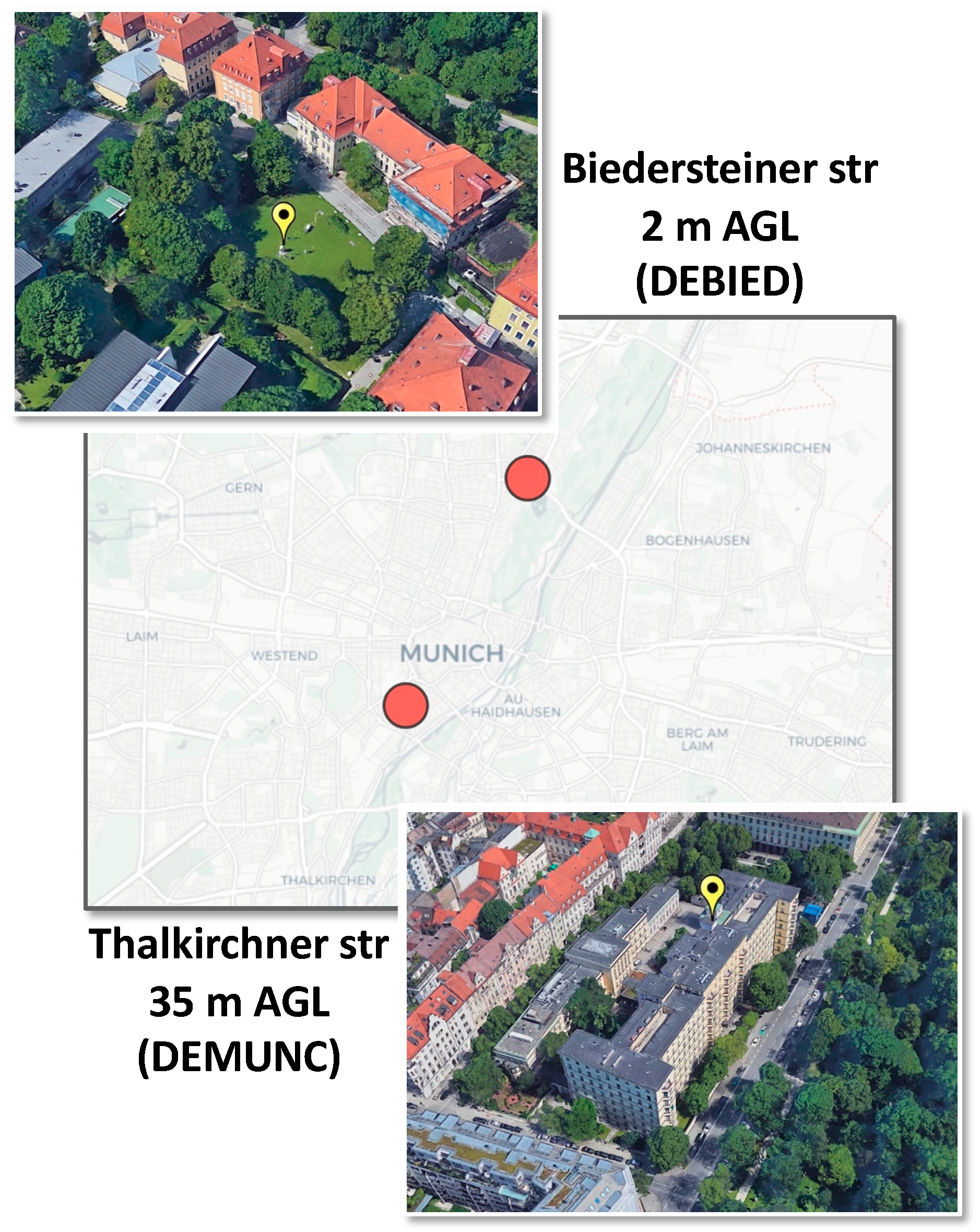
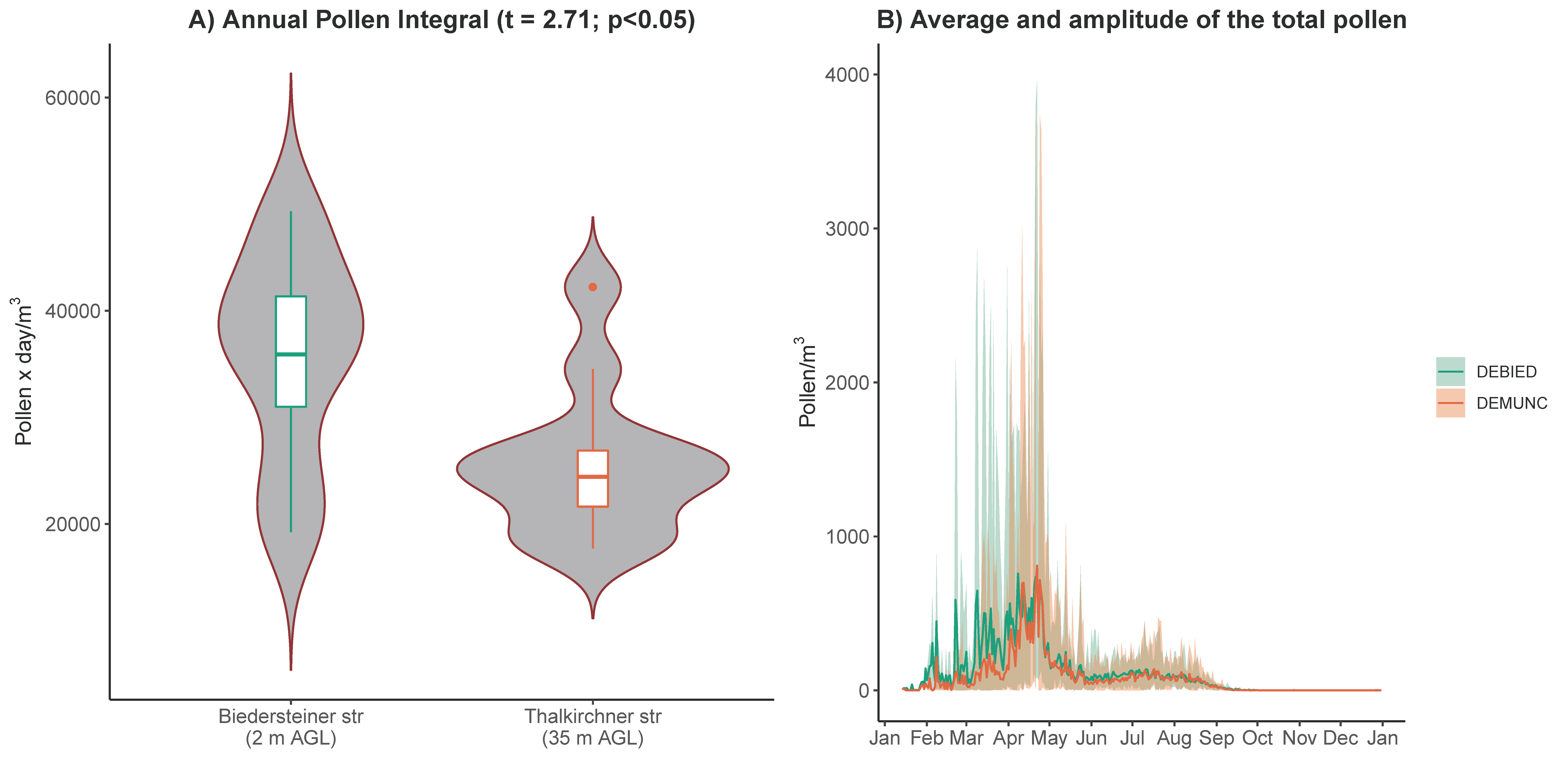
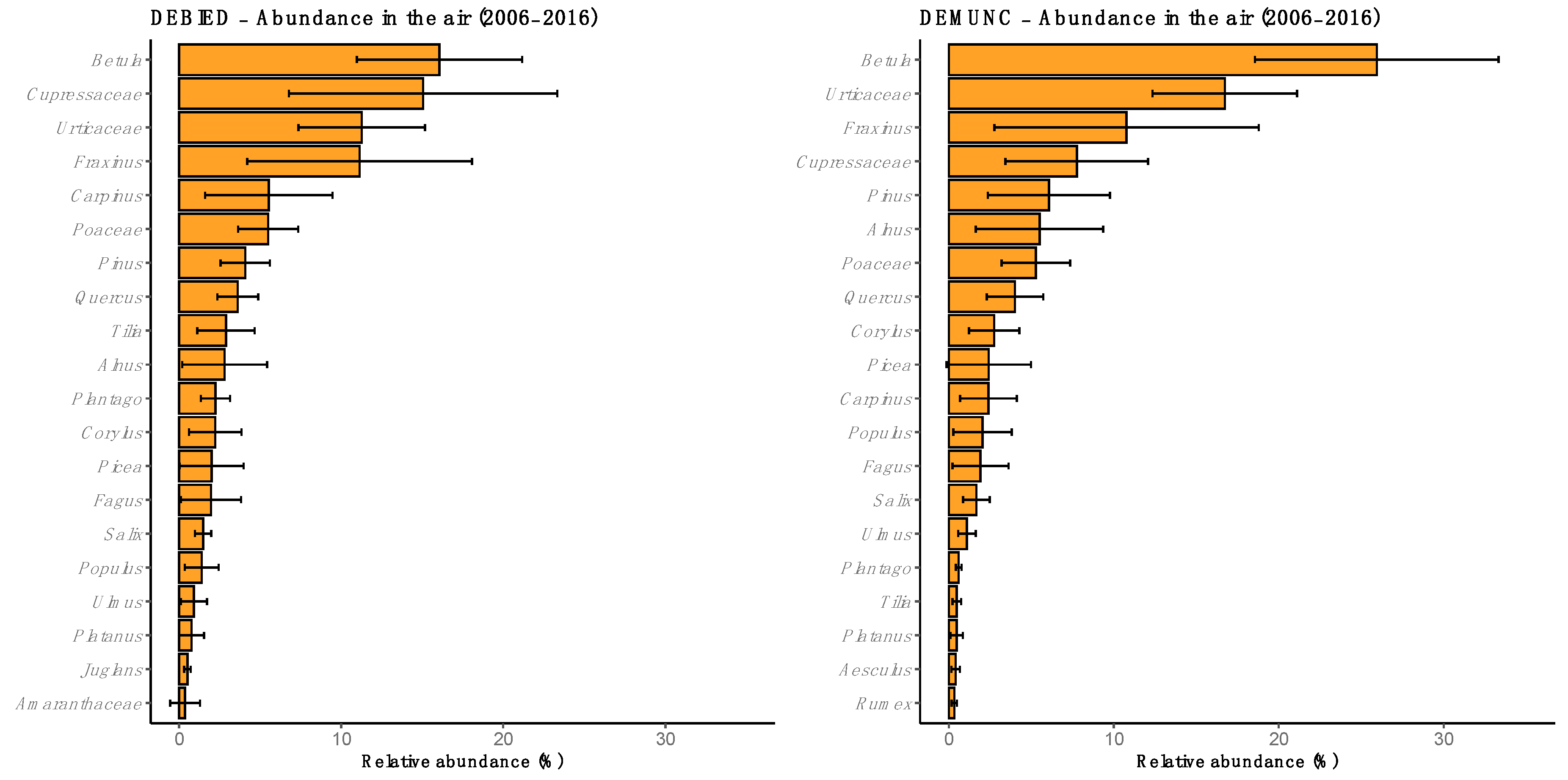
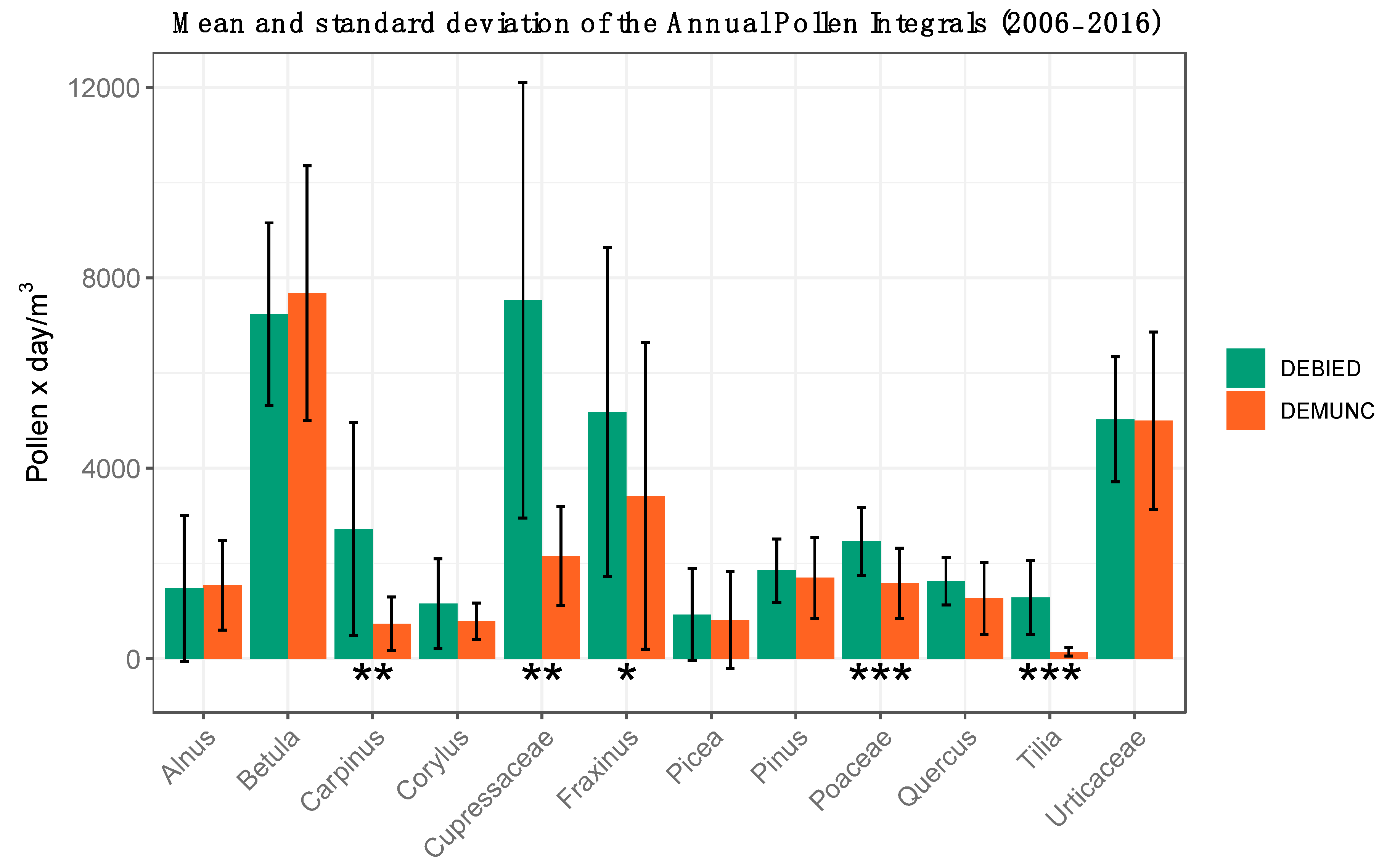
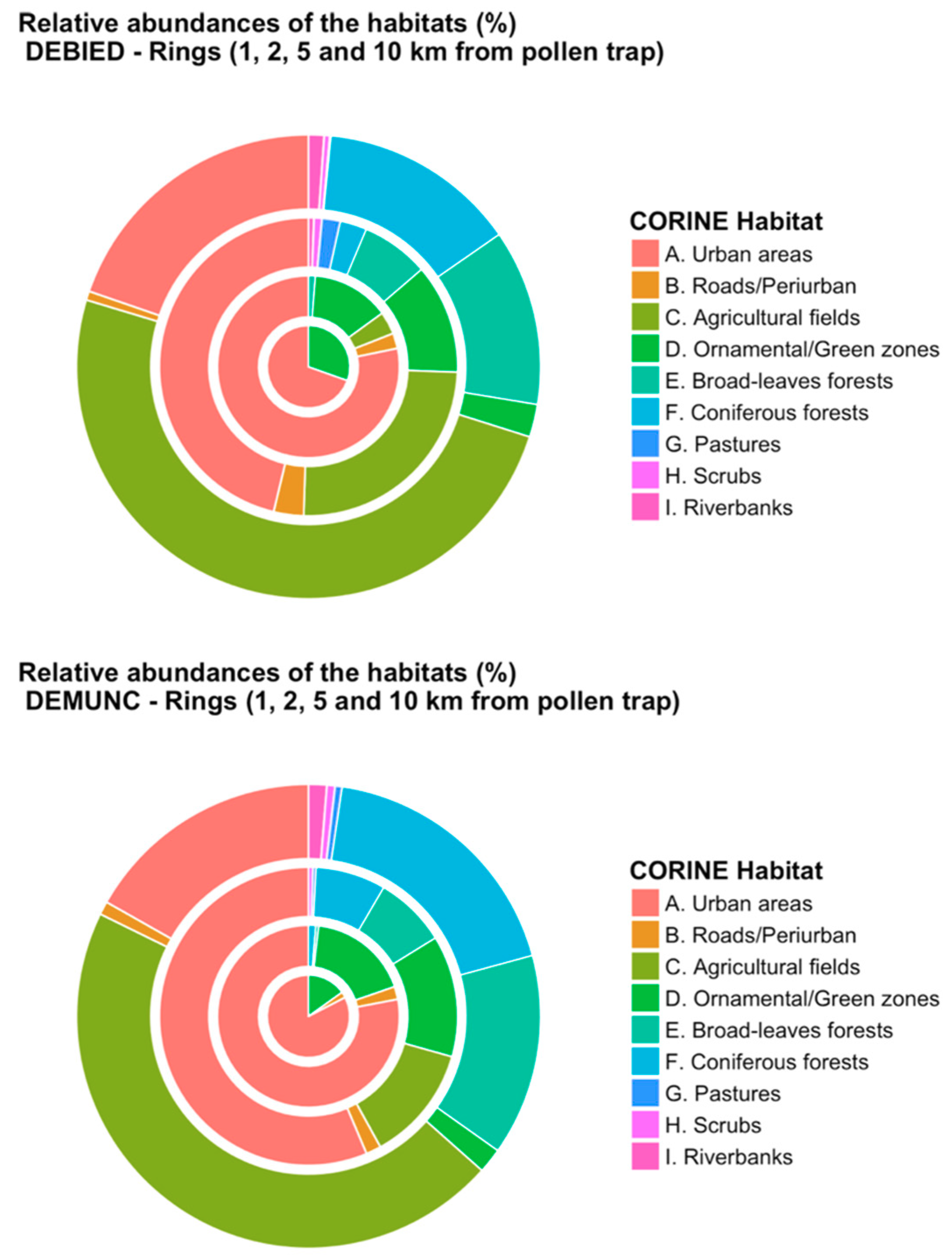
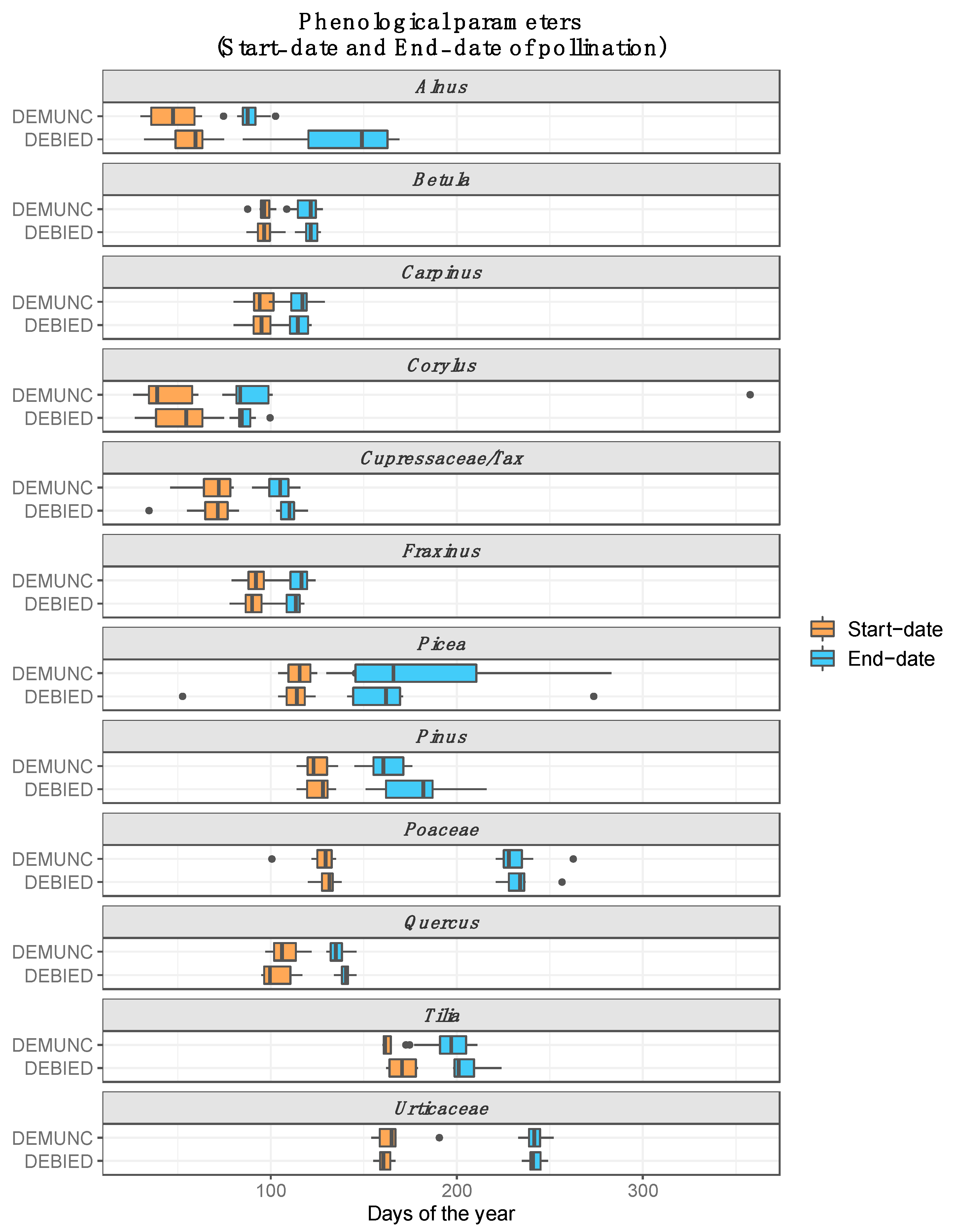
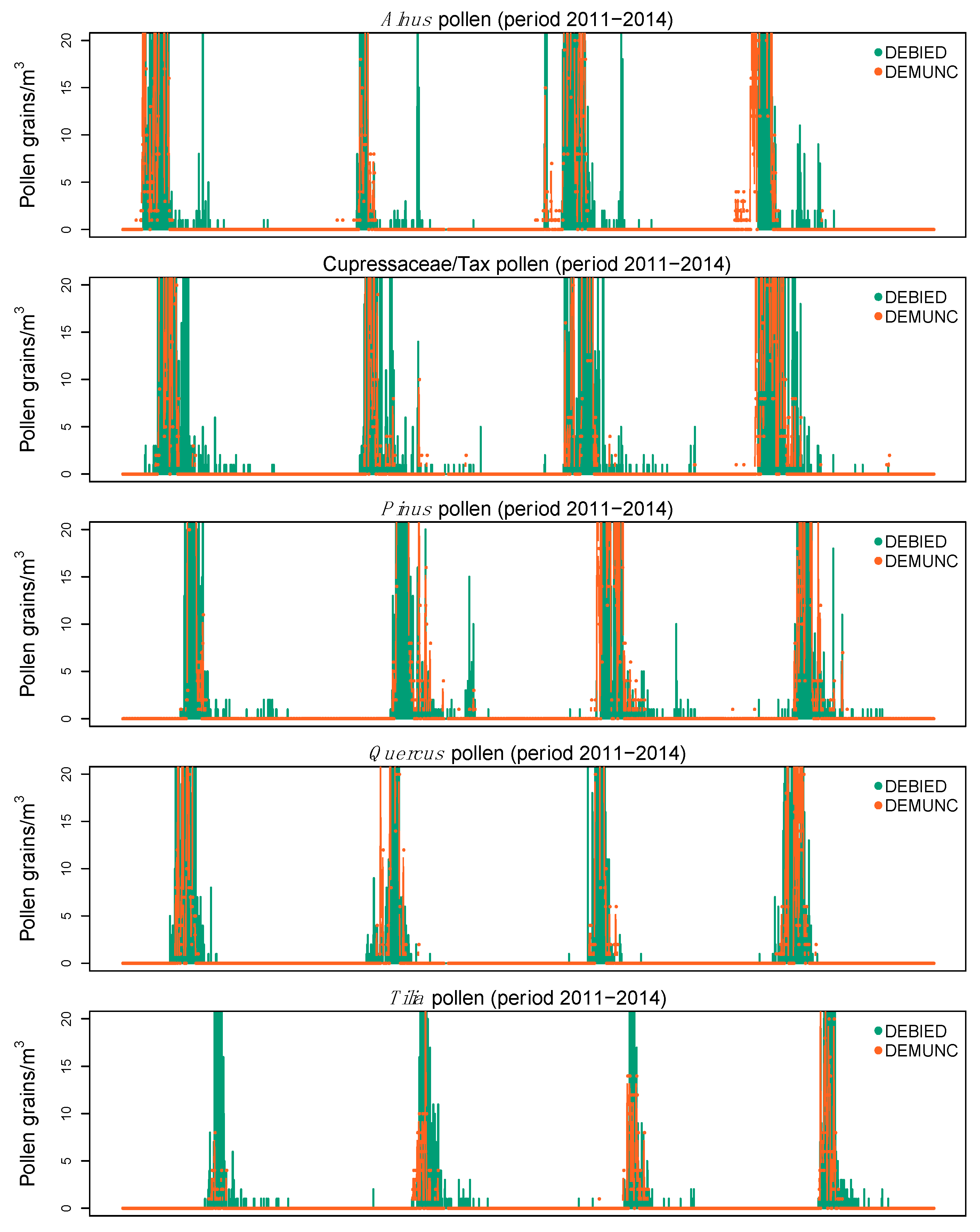
| Year | Alnu (R2/s) | Betu (R2/s) | Carp (R2/s) | Cory (R2/s) | Cupr (R2/s) | Frax (R2/s) | Pice (R2/s) | Pinu (R2/s) | Poac (R2/s) | Quer (R2/s) | Tili (R2/s) | Urti (R2/s) |
|---|---|---|---|---|---|---|---|---|---|---|---|---|
| 2006 | - | 0.6/0.9 | 0.0/0.0 | 0.9/0.6 | 0.5/0.3 | 0.8/0.9 | 0.7/0.8 | 0.4/1.0 | 0.1/0.2 | 0.5/0.7 | -/0.3 | 0.3/1.0 |
| 2007 | - | 0.9/1.7 | 0.1/0.1 | - | 0.9/2.2 | 0.8/1.3 | -/1.4 | 0.3/0.6 | 0.6/0.7 | 0.7/1.3 | -/0.0 | 0.3/1.0 |
| 2008 | - | 0.9/1.4 | - | - | - | - | 0.0/0.0 | 0.2/0.5 | 0.1/0.2 | 0.3/0.3 | - | 0.2/0.5 |
| 2009 | 0.1/0.4 | 0.7/2.3 | 0.8/0.5 | 0.9/0.5 | 0.7/0.4 | 0.5/1.7 | 0.5/1.0 | 0.5/0.7 | 0.0/0.2 | 0.5/0.8 | - | 0.4/0.6 |
| 2010 | 0.2/0.3 | 0.9/0.9 | -/0.8 | 0.5/0.4 | 0.4/0.4 | 0.8/0.4 | - | 0.9/1.0 | 0.0/0.0 | 0.9/0.7 | - | 0.3/0.5 |
| 2011 | 0.7/0.5 | 0.7/0.6 | 0.0/0.0 | 0.5/0.4 | 0.5/0.2 | 0.8/0.5 | -/0.4 | 0.7/0.7 | 0.6/0.2 | 0.6/0.4 | - | 0.2/0.2 |
| 2012 | 0.4/0.2 | 0.6/1.0 | 0.6/-0.1 | 0.1/0.1 | 0.8/0.2 | 0.3/0.2 | - | 0.9/1.3 | 0.5/0.6 | 0.8/1.2 | - | 0.5/0.9 |
| 2013 | 0.6/0.5 | 0.9/1.3 | 0.3/0.2 | 0.8/0.3 | 0.5/0.2 | 0.9/0.8 | 0.6/0.7 | 0.7/0.9 | 0.4/0.5 | 0.9/1.2 | -/0.2 | 0.8/1.3 |
| 2014 | 0.7/1.3 | 0.8/1.0 | 0.0/0.1 | 0.4/0.7 | 0.6/0.1 | 0.5/0.8 | 0.2/0.6 | 0.7/0.8 | 0.6/0.8 | 0.2/0.3 | 0.2/0.0 | 0.3/0.8 |
| 2015 | 0.8/0.8 | 0.9/0.8 | 0.5/0.1 | -/1.2 | 0.3/0.2 | 0.9/0.6 | 1.0/0.9 | 0.6/0.5 | 1.0/0.5 | 0.8/1.4 | 0.1/0.0 | 0.6/0.8 |
| 2016 | 0.6/0.3 | 0.9/0.7 | 0.5/0.3 | 0.9/0.5 | -/0.1 | 0.7/0.6 | -/1.0 | 0.9/0.6 | 0.3/0.4 | 0.9/0.5 | -/0.0 | 0.5/0.9 |
| Mean | 0.5/0.5 | 0.8/1.1 | 0.3/0.2 | 0.6/0.5 | 0.6/0.4 | 0.7/0.7 | 0.5/0.8 | 0.6/0.7 | 0.3/0.4 | 0.7/0.8 | 0.2/0.1 | 0.4/0.8 |
| Pollen Type | Start Date (DEBIED/DEMUNC) | End Date (DEBIED/DEMUNC) |
|---|---|---|
| Alnus | 55.8 ± 13.6/47.1 ± 13.6 (n.s.) | 137.5 ± 34.1/88.5 ± 9.1 ** |
| Betula | 96.5 ± 6.6/97.2 ± 6.3 (n.s.) | 121.1 ± 4.8/119.1 ± 7.5 (n.s.) |
| Carpinus | 95.1 ± 8.8/95.2 ± 8.8 (n.s.) | 114.0 ± 6.8/115.4 ± 9.2 (n.s.) |
| Corylus | 51.4 ± 17.4/43.5 ± 14.0 (n.s.) | 86.2 ± 6.7/119.9 ± 96.2 (n.s.) |
| Cupressaceae/Tax | 67.2 ± 15.9/68.4 ± 12.8 (n.s.) | 110.1 ± 6.0/104.1 ± 8.3 * |
| Fraxinus | 91.0 ± 8.6/92.1 ± 8.4 (n.s.) | 111.1 ± 6.9/114.6 ± 7.5 (n.s.) |
| Picea | 106.9 ± 23.0/117.9 ± 12.8 (n.s.) | 170.6 ± 43.1/186.1 ± 56.4 (n.s.) |
| Pinus | 125.6 ± 7.4/124.5 ± 7.4 (n.s.) | 178.6 ± 20.7/161.5 ± 10.9 * |
| Poaceae | 130.5 ± 5.9/126.1 ± 11.4 (n.s.) | 233.8 ± 10.9/232.8 ± 13.3 (n.s.) |
| Quercus | 103.4 ± 9.0/107.5 ± 8.6 (n.s.) | 140.0 ± 3.8/136.0 ± 5.6 * |
| Tilia | 170.6 ± 7.1/164.0 ± 5.6 * | 205.0 ± 9.0/196.8 ± 11.2 * |
| Urticaceae | 161.1 ± 4.0/165.5 ± 11.1 (n.s.) | 242.0 ± 4.8/241.8 ± 6.1 (n.s.) |
© 2020 by the authors. Licensee MDPI, Basel, Switzerland. This article is an open access article distributed under the terms and conditions of the Creative Commons Attribution (CC BY) license (http://creativecommons.org/licenses/by/4.0/).
Share and Cite
Rojo, J.; Oteros, J.; Picornell, A.; Ruëff, F.; Werchan, B.; Werchan, M.; Bergmann, K.-C.; Schmidt-Weber, C.B.; Buters, J. Land-Use and Height of Pollen Sampling Affect Pollen Exposure in Munich, Germany. Atmosphere 2020, 11, 145. https://doi.org/10.3390/atmos11020145
Rojo J, Oteros J, Picornell A, Ruëff F, Werchan B, Werchan M, Bergmann K-C, Schmidt-Weber CB, Buters J. Land-Use and Height of Pollen Sampling Affect Pollen Exposure in Munich, Germany. Atmosphere. 2020; 11(2):145. https://doi.org/10.3390/atmos11020145
Chicago/Turabian StyleRojo, Jesús, Jose Oteros, Antonio Picornell, Franziska Ruëff, Barbora Werchan, Matthias Werchan, Karl-Christian Bergmann, Carsten B. Schmidt-Weber, and Jeroen Buters. 2020. "Land-Use and Height of Pollen Sampling Affect Pollen Exposure in Munich, Germany" Atmosphere 11, no. 2: 145. https://doi.org/10.3390/atmos11020145
APA StyleRojo, J., Oteros, J., Picornell, A., Ruëff, F., Werchan, B., Werchan, M., Bergmann, K.-C., Schmidt-Weber, C. B., & Buters, J. (2020). Land-Use and Height of Pollen Sampling Affect Pollen Exposure in Munich, Germany. Atmosphere, 11(2), 145. https://doi.org/10.3390/atmos11020145






